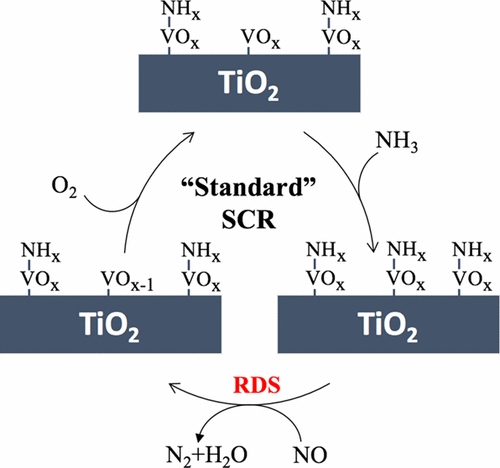当前位置:
X-MOL 学术
›
ACS Catal.
›
论文详情
Our official English website, www.x-mol.net, welcomes your feedback! (Note: you will need to create a separate account there.)
Reaction Pathways and Kinetics for Selective Catalytic Reduction (SCR) of Acidic NOx Emissions from Power Plants with NH3
ACS Catalysis ( IF 12.9 ) Pub Date : 2017-11-08 00:00:00 , DOI: 10.1021/acscatal.7b03149 Minghui Zhu 1 , Jun-Kun Lai 1 , Uma Tumuluri 2 , Michael E. Ford 1 , Zili Wu 2 , Israel E. Wachs 1
ACS Catalysis ( IF 12.9 ) Pub Date : 2017-11-08 00:00:00 , DOI: 10.1021/acscatal.7b03149 Minghui Zhu 1 , Jun-Kun Lai 1 , Uma Tumuluri 2 , Michael E. Ford 1 , Zili Wu 2 , Israel E. Wachs 1
Affiliation

|
Selective catalytic reduction (SCR) of NOx with NH3 by supported vanadium oxide catalysts is an important technology for reducing acidic NOx emissions from stationary sources and mobile diesel vehicles. However, rational design of improved catalysts is still hampered by a lack of consensus about reaction pathways and kinetics of this critical technology. The SCR fundamentals were resolved by applying multiple time-resolved in situ spectroscopies (ultraviolet–visible light (UV-vis), Raman and temperature-programmed surface reaction (TPSR)) and isotopically labeled molecules (18O2, H218O, 15N18O, ND3). This series of experiments directly revealed that the SCR reaction occurs at surface V5+O4 sites that are maintained in the oxidized state by O2 and the rate-determining step involves the reduction of V5+O4 sites by NO and NH3, specifically the breaking of N–H bonds during the course of formation or decomposition of the NO–NH3 intermediate.
中文翻译:

NH 3对发电厂酸性NO x排放进行选择性催化还原(SCR)的反应途径和动力学
NO选择性催化还原(SCR)X与NH 3通过支持钒氧化物催化剂是用于减少酸性NO的重要技术X从固定源和移动柴油车辆排放。然而,由于对该关键技术的反应途径和动力学缺乏共识,仍然阻碍了改进催化剂的合理设计。通过应用多种时间分辨的原位光谱仪(紫外可见光(UV-vis),拉曼光谱和温度程序化表面反应(TPSR))和同位素标记的分子(18 O 2,H 2 18 O,15 N 18 O,ND 3)。这一系列实验直接表明SCR反应发生在表面V 5+ O 4位点,该位点被O 2保持在氧化状态,并且速率确定步骤涉及NO和NH 3还原V 5+ O 4位点。,特别是在NO-NH 3中间体的形成或分解过程中,NH键的断裂。
更新日期:2017-11-09
中文翻译:

NH 3对发电厂酸性NO x排放进行选择性催化还原(SCR)的反应途径和动力学
NO选择性催化还原(SCR)X与NH 3通过支持钒氧化物催化剂是用于减少酸性NO的重要技术X从固定源和移动柴油车辆排放。然而,由于对该关键技术的反应途径和动力学缺乏共识,仍然阻碍了改进催化剂的合理设计。通过应用多种时间分辨的原位光谱仪(紫外可见光(UV-vis),拉曼光谱和温度程序化表面反应(TPSR))和同位素标记的分子(18 O 2,H 2 18 O,15 N 18 O,ND 3)。这一系列实验直接表明SCR反应发生在表面V 5+ O 4位点,该位点被O 2保持在氧化状态,并且速率确定步骤涉及NO和NH 3还原V 5+ O 4位点。,特别是在NO-NH 3中间体的形成或分解过程中,NH键的断裂。


























 京公网安备 11010802027423号
京公网安备 11010802027423号